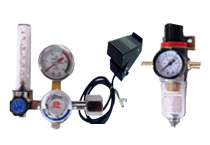
Frequency control - A way to improve aluminum Welding
Adjustable-output frequency has been pivotal in emerging technologies that have made Gas Tungsten Arc Welding (GTAW) applications more adaptable for aluminum welding - particularly after the advent of inverter-based GTAW machines. Advanced inverter-based welding machines give welding persons the possibility to enhance shaping of the bead profile - frequency control.
Decreasing frequency produces a broader arc cone, which widens the weld bead profile and more effectively removes impurities from the surface of the metal. It also transfers the maximum amount of energy to the work piece. Increasing frequency produces a tight, focused arc cone. This helps deeper penetration and it narrows the weld bead, which is useful when welding in corners, on root passes and fillet welds.
Conventional AC TIG Welders have a fixed output of 50 or 60 Hz, but certain inverters provide the operator the option to adjust the welding output frequency. While referring to Alternating Current (AC), GTAW frequency means the number of times that the direction of the electrical current completes a full cycle per second, expressed in terms of hertz. Frequency is represented by a sine wave, which depicts the current flow rising and falling as it reverses direction.
Gas tungsten arc welding (GTAW) or tungsten inert gas (TIG) welding is widely deemed as the most difficult welding process to master. AC GTAW inverters-through new arc controls and waveform options-have made it easier for operators to fashion arc characteristics, weld puddle behavior, weld bead profile, penetration, and appearance.
Of course, Direct current (DC) cannot be used with nonferrous metals like aluminum because of the oxide layer that forms on the surface of the base material. With DC electrode negative (DCEN) GTAW, the current flows from the tungsten electrode to the work surface, and the positively charged argon gas ions flow from the work surface to the tungsten.
DCEN works well most ferrous metals principally steel, but the oxide layer that forms on nonferrous metals like aluminum melts at a higher temperature than the base metal making welding difficult. But Direct Current Electrode Positive (DCEP) solves the oxide problem in a way because the current flows from the work surface to the tungsten, lifting the oxide off the material in the arc zone.
The range of most inverter-based power sources provide AC output frequencies between 20 Hz and 150 Hz. Miller inverter TIG machines provide AC output frequencies between 20-400 Hz output frequencies. Some manufacturers offer machines with frequencies from 20 to 100 Hz, while others make machines outputting 20- to 400-Hz. In general, 120 to 200 Hz is a suitable frequency for most aluminum welding.
An inverter power source takes input power, filters it to DC, and, increases its frequency up to 100,000 Hz with fast, solid-state switches. Input power then is transformed into usable, and then transforms it into useable welding power with an advanced level of arc control.
The ideal starting point for general welding may be 80 to 120 Hz and increase control of the arc direction and boost travel speed. For a fillet weld application with full penetration in the weld, increase the frequency to 225 to 250 Hz. For build up work, start at 60 Hz and adjust lower from there.






